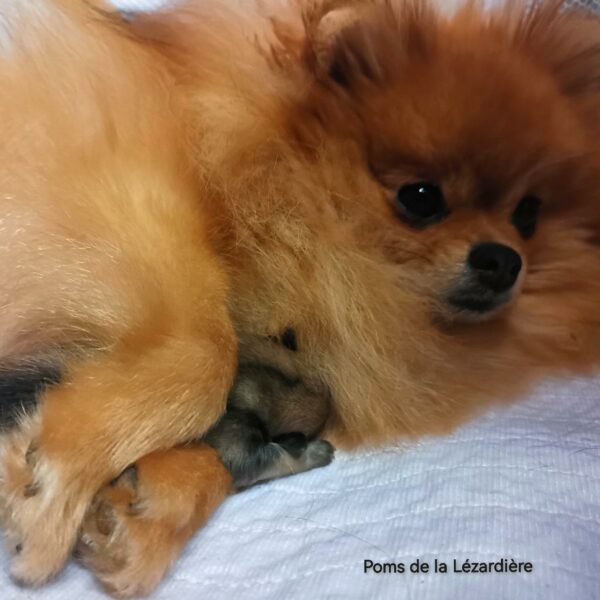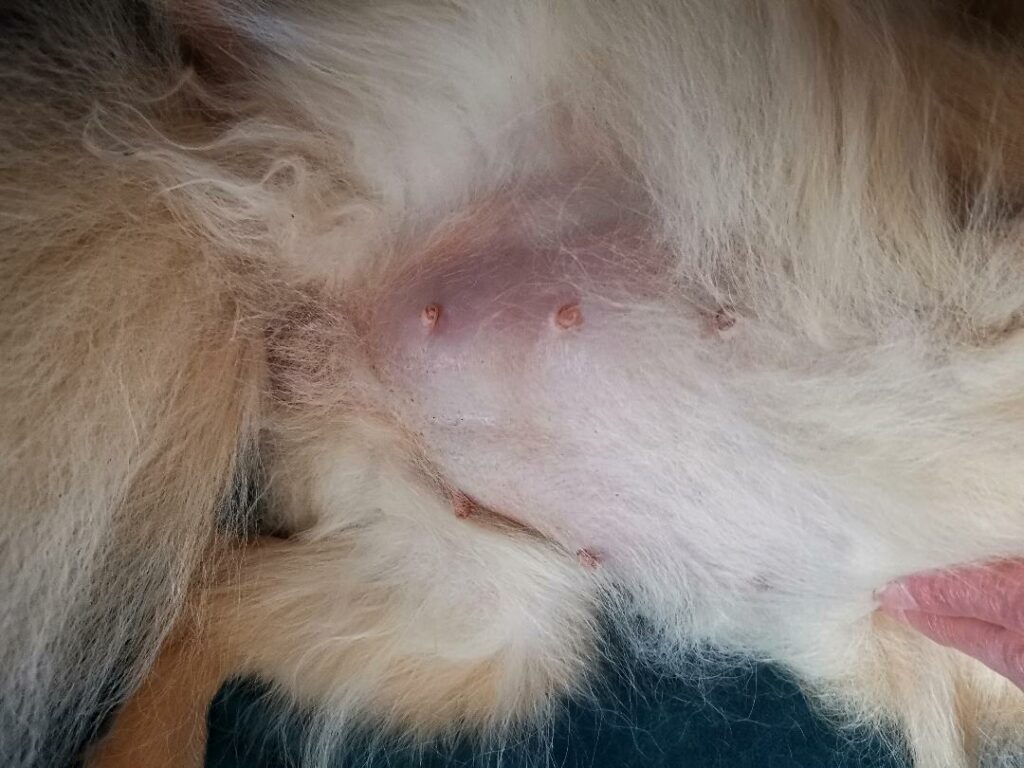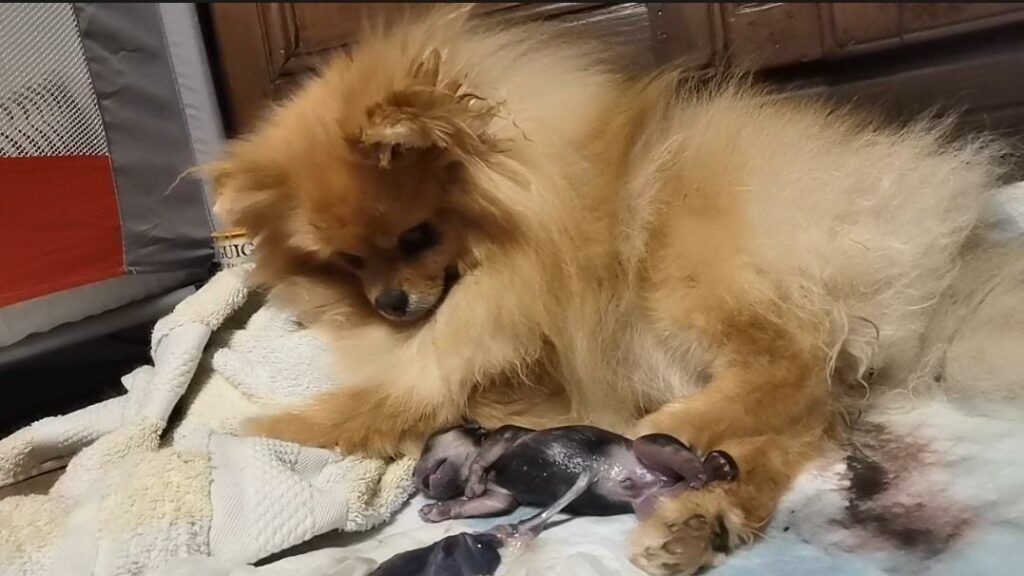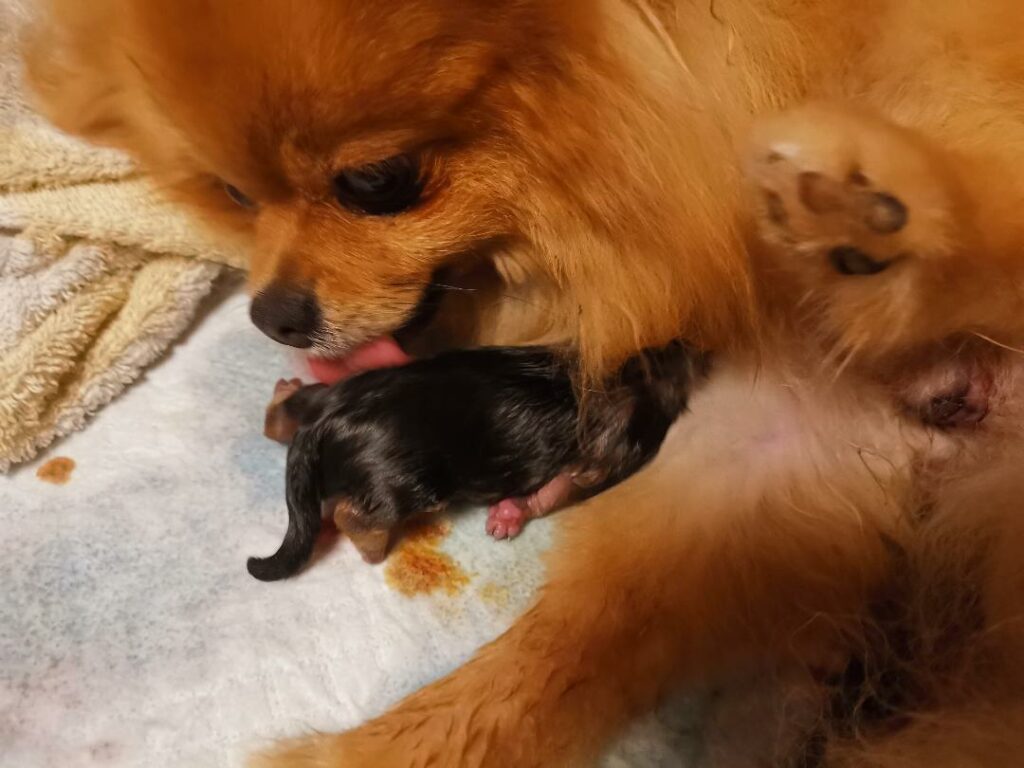Gestation and whelping
I wanted to share this new theme with you:
The bitch during gestation and whelping.
In the next article, we’ll talk about caring for puppies from birth.
This chapter shows what life is like for the breeders, from caring for the female…
If you have a bitch and you want to give her puppies, you mustn’t think that everything will be easy, that the bitch will have her puppies without a hitch and that everything will just happen. You have to learn how to monitor, it’s a real profession.
Gestation and birth often go well. But complications and emergencies can occur, and in these cases you need to be reactive and know what to do… so as not to lose either the puppies or the mother!
The breeder is not just someone who feeds, cleans… but someone who gives 400%, 24 hours a day, 365 days a year to care, cuddle, love, feed, educate, socialise in all its forms…
Here’s a quick overview of how to monitor a pregnant bitch.




Gestation period






Whelping

Reference : hopitalveterinairerdl.com
When will the puppies come out?
– Drop in rectal temperature: this is an interesting sign to take into account. To avoid missing it (as it is transitory and will only last 12 to 20 hours), the bitch’s temperature should be taken in the morning and evening. In the 24 hours preceding whelping, the rectal temperature will fall by around one degree Celsius.
– Establishment of lactation: the udders begin to enlarge from the second month of gestation. Their development will be at its peak around a week before whelping. For primiparous bitches (= bitches having their first litter), lactation is generally established in the 24 hours before parturition. For pluriparous bitches (= bitches that have already had a litter) colostrum may already be present a week before.
– Swelling of the vulva can be observed in the days leading up to childbirth. However, in primiparous females, this change may be discreet, occurring only a few hours before whelping.
– The appearance of cervical mucus in the vulva (a colourless, translucent viscous liquid) is the latest sign: just before the onset of labour.
How will the whelping go?
First there is a preparatory phase lasting 2 to 10 hours (up to 36 hours for primiparous women). During this phase, the bitch is anxious and agitated. It is looking for a quiet place “to nest”. The bitch refuses to eat, breathes rapidly and may sometimes start vomiting. The bitch should not be disturbed or stressed during this phase, as this could delay or prevent her giving birth.
The first uterine contractions begin, but they are intermittent and non-voluntary and are not accompanied by abdominal contractions. During this preparatory period, the cervix dilates.
The second phase corresponds to the expulsion of the puppies. This phase generally lasts less than 12 hours, but can last up to 36 hours in a primipara. The contractions of the uterus are now accompanied by contractions of the abdomen, allowing the puppies to be expelled. The first baby takes the longest to come out (up to 6 hours after expulsion begins), and the average time between 2 births is then between 10 and 60 minutes. Puppies are surrounded by the amniotic sac, which normally ruptures as they progress through the uterus. If this is not the case, the mother ruptures it at birth. If the amniotic sac is intact and the mother doesn’t open it, it’s up to you to clear it within 2 minutes of birth (otherwise the puppy won’t be able to breathe). The mother immediately licks the puppy (which stimulates breathing) and cuts the umbilical cord with her teeth.
A few minutes after the puppy is expelled, the placenta is also expelled. The contractions will then become less frequent before the next puppy.
What to expect?
To prepare for the birth, you’ll need to find a quiet, draught-free place where the bitch can “nest”. Having a crate for whelping is a plus (a large crate with high sides to prevent puppies moving away from their mother and anti-crush bars (for large dogs)). Fill it with a clean blanket. You can also bring an infra-red lamp to keep the box warm (ideal nest temperature: 28 to 30 degrees), a pair of clean scissors disinfected with alcohol and thread if you need to cut the cords, clean towels, a thermometer and betadine®.
The bitch must not be disturbed and must remain calm (avoid disturbing her by talking to her or stroking her too much). Your intervention is not normally necessary. However, you need to stay close by to monitor the process.
What can I do?
Should the umbilical cord be cut?
Normally not, as the bitch normally has to break it off with her teeth. If she has not done so after 15 minutes: tighten the cord with disinfected thread to about 2.5 cm from the navel, then cut with scissors about 1.5 cm after the ligature (i.e. about 4 cm from the navel). Then you need to disinfect the stump with a little Betadine® on a compress.
What should I do if a puppy isn’t breathing?
It is normally the mother who stimulates breathing by licking the puppy. If breathing does not start, the puppy will need to be resuscitated. To do this, start by clearing the respiratory tract (suck out fluids with a bulb or baby fly), then rub the puppy’s chest vigorously with a dry, warm cloth.
My dog has a green discharge coming out of her vulva. Is this normal?
The green colour of uterine discharge is normal and corresponds to the presence of a green pigment derived from the breakdown of blood in the placenta.
When to call the vet?
– if gestation has exceeded 65 days
– if the time between 2 puppies exceeds 2 hours
– if the green discharge has occurred but the first puppy has still not come out 6 hours later.
– my dog is not well, she worries me: squeaks, bleeds…
– The number of puppies that came out did not correspond to the expected number and my dog has not had any contractions for 2 hours.
– My dog gave birth a few days ago and now her discharge is smelly (risk of uterine infection).
– my dog gave birth some time ago and now she is shaking and breathing fast (risk of eclampsia)
Puppy care
After birth, the puppies should be kept warm and their body temperature monitored, which should be 35.5°C at birth, then 36.5°C in the 1st week and 38.0°C in the 3rd week.
Feeding and weight gain must be checked, and the puppies weighed every day.
We’ll talk about this in the next chapter.
References: blog by Dr Charlotte Renard, veterinary consultant for Direct-Vet
More information?
videos
In this video:
👉 What checks should be carried out by your vet to find out how many puppies the bitch is expecting?
👉 At what precise times should these pregnancy monitoring checks be carried out?
👉 When should pregnant bitches be rationed and wormed?
👉 How many litters of puppies on average can be born, depending on the bitch’s breed? Because the difference between a Yorkie and a Mastiff is huge!
👉 And lots of other questions and answers to certain preconceived ideas…
We talked about this with my veterinary colleague specialising in reproduction, Dr Juliette Roos-Pichenot, a partner at Anirepro, in the EVOLIA clinic. 👩🏻⚕️
In this video:
👉 What are the warning signs that a bitch is about to give birth?
👉 How often should puppies be born?
👉 How long can a give birth session last in total?
👉 What are the signs of a puppy stuck in an anterior position?
👉 Or a puppy stuck in a posterior position? 👉 And what can be done in each case?
👉 What do the bitch and her puppies do immediately after giving birth?
We talked about this with my veterinary colleague specialising in reproduction, Dr Juliette Roos-Pichenot, a partner at Anirepro, in the EVOLIA clinic. 👩🏻⚕️
Laura acts as midwife and, above all, provides moral support during the whelping of her dog Brumby. Four little puppies can’t wait to get out and discover the world!
In this video:
👉 What is the 1st step in caring for puppies as soon as they give birth?
👉 How should a bitch who has just given birth be cared for?
👉 What should puppies be checked for first to ensure they are healthy?
👉 What are the particularities of the bitch during whelping?
👉 And why is colostrum so important for puppies?
👉 Finally, what should you do if the bitch doesn’t look after her puppies?
We talked about this with my veterinary colleague specialising in reproduction, Dr Juliette Roos-Pichenot, a partner at Anirepro, in the EVOLIA clinic. 👩🏻⚕️




